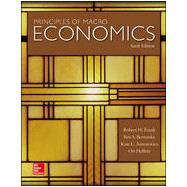Principles of Macroeconomics + Economy 2009 Updates

Principles of Macroeconomics + Economy 2009 Updates
- ISBN 13:
9780077354312
- ISBN 10:
0077354311
- Edition: 4th
- Format: Package
- Copyright: 07/10/2009
- Publisher: McGraw-Hill/Irwin
- Newer Edition
Rent
Sorry, this item is currently unavailable.
Note: Supplemental materials are not guaranteed with Rental or Used book purchases.
Extend or Purchase Your Rental at Any Time
Need to keep your rental past your due date? At any time before your due date you can extend or purchase your rental through your account.
Summary
In recent years, innovative texts in mathematics, science, foreign languages, and other fields have achieved dramatic pedagogical gains by abandoning the traditional encyclopedic approach in favor of attempting to teach a short list of core principles in depth. Two well-respected writers and researchers, Bob Frank and Ben Bernanke, have shown that the less-is-more approach affords similar gains in introductory economics. Although a few other texts have paid lip service to this new approach, Frank/Bernanke is by far the best throughout, and the best executed principles text in this mold. Avoiding excessive reliance on formal mathematical derivations, it presents concepts intuitively through examples drawn from familiar contexts. The authors introduce a coherent short list of core principles and reinforce them by illustrating and applying each in numerous contexts. Students are periodically asked to apply these principles and to answer related questions and exercises...Frank/Bernanke also encourages students to become �Economic Naturalists,� by employing basic economic principles to understand and explain what they observe in the world around them. An economic naturalist understands, for example, that infant safety seats are required in cars but not in airplanes because the marginal cost of space to accommodate these seats is typically zero in cars but often hundreds of dollars in airplanes. Such examples engage student interest while teaching them to see each feature of their economic landscape as the reflection of an implicit or explicit cost-benefit calculation. .








![Principles of Macroeconomics [Rental Edition] 9781260111002](http://simages.knetbooks.com/images/d/1/002/9781260111002.jpg)
![Principles of Macroeconomics [Rental Edition] 9781264250318](http://simages.knetbooks.com/images/d/0/318/9781264250318.jpg)


